
Fried rice has a lot going for it. It's fast, it can be made with just about any set of ingredients, it's cheap to make, and—above all—it's totally delicious when made well. Unfortunately, I find it's not a dish most home cooks spend much time trying to learn. That's too bad, because once you’ve added it to your culinary lexicon, I think you’ll be amazed at its versatility, and you’ll go back to it more often than you could have expected. It’s even, in my opinion, the best way to use up the stuff lingering in your fridge that you otherwise would have thrown into a much more complicated and time consuming quiche, frittata, or casserole (or just let slowly rot in some unseen corner while wondering aloud why the fridge “smells like that”).
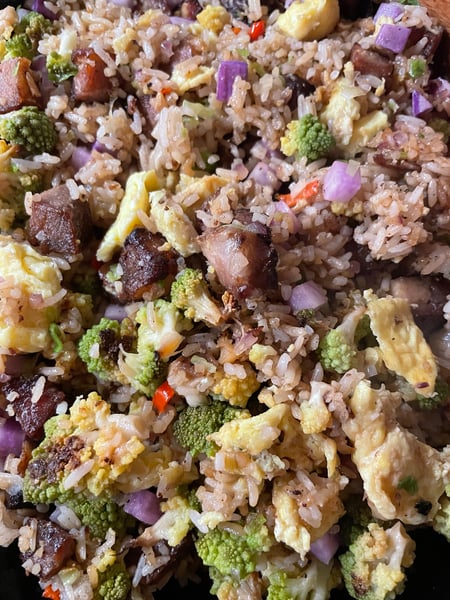 There are many different styles of fried rice in the world. Basically every country that has a strong rice eating tradition has some variation on it. Many people get rather opinionated when it comes to the preparation of fried rice, especially with the rising popularity of a certain fried rice focused comedy YouTube presence (for whom I will not be buzz marketing in this post), and get fixated on whether the fried rice was made “properly” or whether its “authentic” or “traditional”.
There are many different styles of fried rice in the world. Basically every country that has a strong rice eating tradition has some variation on it. Many people get rather opinionated when it comes to the preparation of fried rice, especially with the rising popularity of a certain fried rice focused comedy YouTube presence (for whom I will not be buzz marketing in this post), and get fixated on whether the fried rice was made “properly” or whether its “authentic” or “traditional”.
As with just about every question of authenticity, the further you zoom in, the less sense the question makes. The more you try to pin it down, the more completely it evades your grasp. Cuisine is a fluid practice. Very few preparations remain completely unchanged through the course of history. So instead of kneeling at the altar of authenticity, I offer you a method for making fried rice that I’ve slowly worked on over my entire cooking career that is, if nothing else, very delicious. Tradition in cooking can be important, sometimes very important, but at the end of the day, what I’m most interested in is results.
This isn’t a proper recipe exactly because the versatility of the method relies on the cook being able to use basically whatever they have on hand, in whatever quantities they may have it. That being said, my mise en place typically falls into 7 categories:
1. Cooking Fat
My most frequently used cooking fat for fried rice is a high heat neutral flavored cooking oil. For me, this means peanut or rice bran oil, but canola, vegetable, grapeseed, avocado, etc. will all work just as well. However, my favorite cooking fat for fried rice is rendered pork lard. It has a lovely rich mouthfeel, and neutral flavor perfect for elevating this simple dish. This method is done over high heat, so ideally avoid fats that tend to break down or burn at lower temps like extra virgin olive oil or butter, but even these will work in a pinch.
2. Protein
To be honest, using a protein in fried rice is totally optional. I’ve made countless delicious vegetarian renditions, but the majority of the time I’m using an animal protein of one sort or another. My most common choice is some form of fatty pork (bacon, roast shoulder), but anything really works here: shrimp, steak, chicken breast, you name it. The one consideration is that you want whatever you choose to be able to cook pretty quickly, so if you’re using a cut of meat that normally takes a while to cook—like chicken thigh or pork shoulder—you’ll want to have cooked it in advance so all you’re doing in the pan is reheating.
3. Rice
Again, really any type of rice will work here. I almost always use medium grain white rice, or jasmine rice, but that just because that’s what I most commonly have leftover from other meals. The conventional wisdom is that the rice for fried rice must be cooked and completely chilled, ideally overnight, in the fridge in order to be good for fried rice. While this does make an excellent product, and is a great way to bring your cold-hardened leftover takeout rice back to life, it isn’t strictly necessary to use cold rice. You can use just cooked rice, basically right out of the pot, though I recommend laying it out on a sheet tray for at least a few minutes to help it firm up a bit so it doesn’t turn to mush in the pan.
4. Aromatic Vegetables
In my opinion, you really can’t have too many aromatics for fried rice. I most often use scallions, garlic and shallots, but you can also use chilies, ginger, onion, celery, lemongrass, or really anything else you like. Remember this dish cooks quickly, so small dice, mince, or thin slices are the way to go for prepping these.
5. Other Vegetables
The most common additions in this category that I think most people who have had fried rice from a takeout restaurant will recognize are peas and carrots. To be sure, these make for a delicious fried rice with interesting texture, a pleasant sweetness, and nice flavor, but you can really put anything you want in. This is most often where I employ vegetables that are lingering in my fridge without any real plan for them. Sometimes I’ll even use leftover vegetables that have already been cooked. Similar to the aromatic vegetables, you’ll want to cut these veggies relatively small so they cook quickly, however since they don’t necessarily need to be fully softened you can go for slightly larger pieces if you like.
6. Eggs
Technically optional, but they’ve been a part of every fried rice I’ve ever made, and I’d say most people consider eggs to be an integral component of the dish. I usually use one egg per serving. You can either scramble the eggs ahead of time in a bowl, or scramble them in the pan as they cook.
7. Seasonings
For a really bare bones fried rice the only seasoning you need is salt, but I’ll also often use some soy sauce, black pepper and MSG.
Now on to the method. First, as I’ve mentioned, this dish cooks quickly over high heat the entire time so its very important to have all your ingredients prepped and at the ready before you begin. Here is what my mise en place looks like:
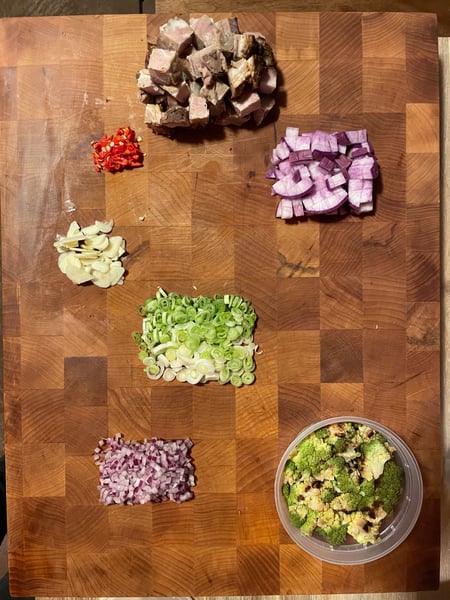 I’m using diced roast pork shoulder, minced Korean red chili, sliced garlic, sliced scallion, brunoise red onion, diced purple daikon, and some roasted cauliflower from earlier in the week. Not pictured are two eggs already scrambled, lard, and soy sauce.
I’m using diced roast pork shoulder, minced Korean red chili, sliced garlic, sliced scallion, brunoise red onion, diced purple daikon, and some roasted cauliflower from earlier in the week. Not pictured are two eggs already scrambled, lard, and soy sauce.
As a non-traditional method, this has been designed to work best in a well seasoned cast iron skillet. Other pans will still work, but for best results I recommend cast iron. Start heating your skillet over medium-high or high heat (depending on how powerful your burner is), and heat up your cooking fat.
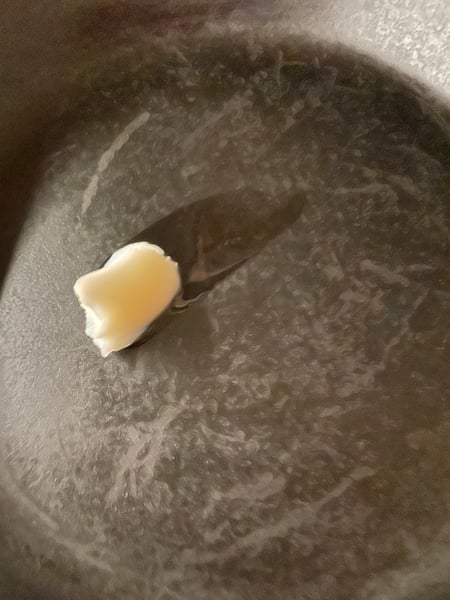 I’m using lard here.
I’m using lard here.
Once your pan is hot and ready to cook add your protein and cook until almost done. If you’re using a pre-cooked option like I am here just cook until it is heated through, and maybe has some nice crispy seared sides.
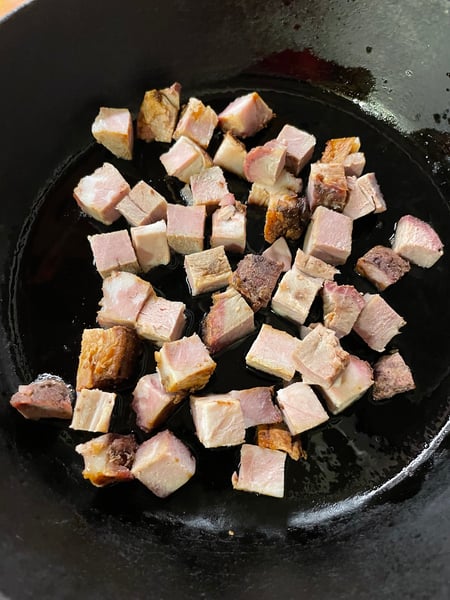
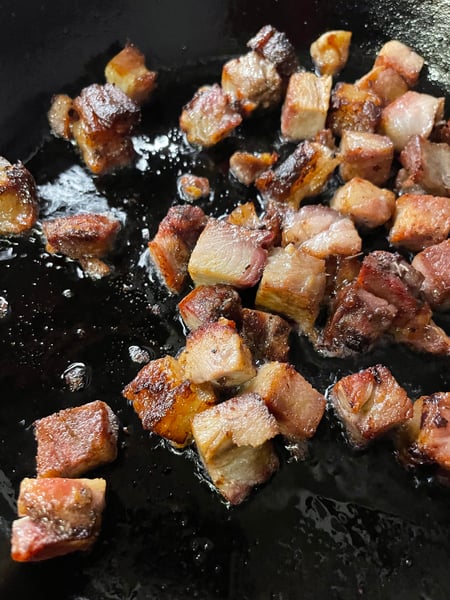 Next, we will add in our rice. You will almost certainly need to add more cooking fat at this point. There should be about a 1/8 inch layer of fat in the pan.
Next, we will add in our rice. You will almost certainly need to add more cooking fat at this point. There should be about a 1/8 inch layer of fat in the pan.
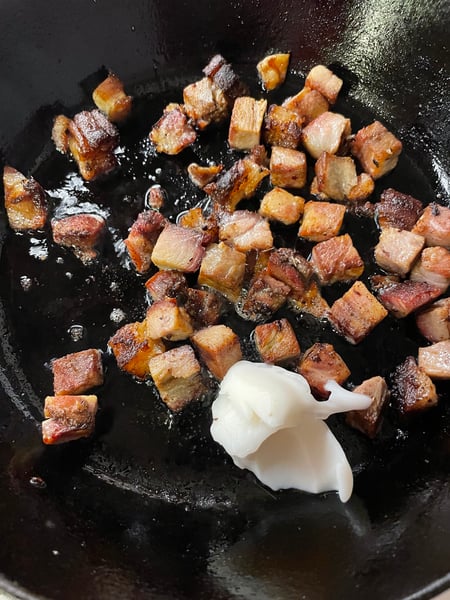
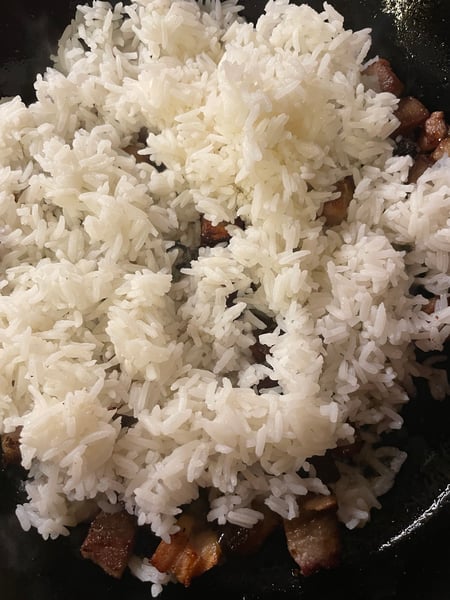
Use an amount of rice suited to the size of the pan. Roughly 2-3 cups of cooked rice pretty much maxes out the capacity of my 10” skillet.
Once your rice is in the pan your goal is to break up the clumps of rice and get every grain coated with cooking fat by constant gentle stirring. It doesn’t need to be drenched in cooking fat—we don’t want greasy fried rice—but each grain should be just barely coated, and glistening.
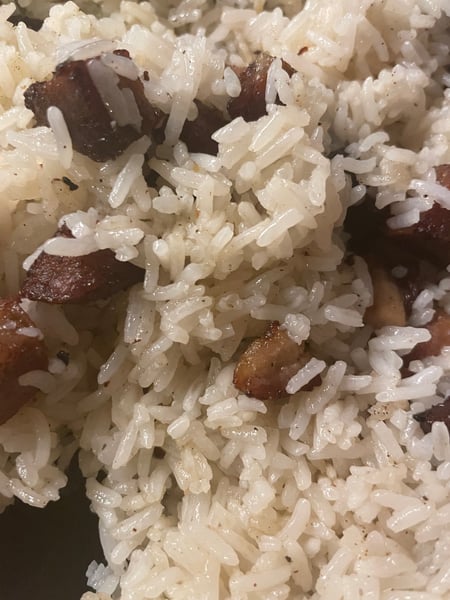 At this point I add the aromatics. I like to add them at this point and not earlier so they can gently steam into the rice as it cooks instead of risking unwanted browning or burning by adding them earlier. I’ll also add a small sprinkle of salt here to help draw out moisture from the aromatics and to lightly season them. Go easy on the salt at this point, we will do more seasoning later. Stir in the aromatics and cook, still over high heat, until they’re just softened.
At this point I add the aromatics. I like to add them at this point and not earlier so they can gently steam into the rice as it cooks instead of risking unwanted browning or burning by adding them earlier. I’ll also add a small sprinkle of salt here to help draw out moisture from the aromatics and to lightly season them. Go easy on the salt at this point, we will do more seasoning later. Stir in the aromatics and cook, still over high heat, until they’re just softened.
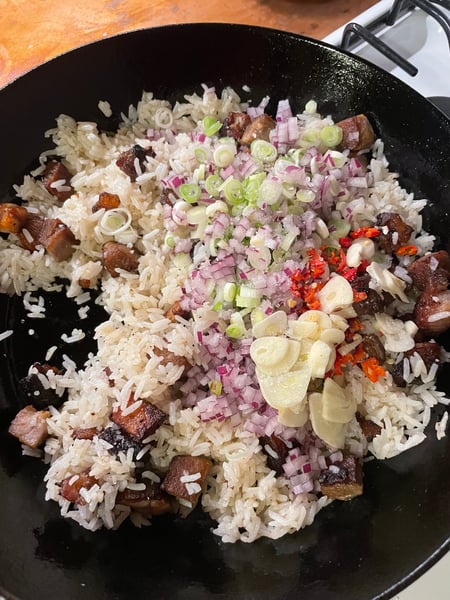
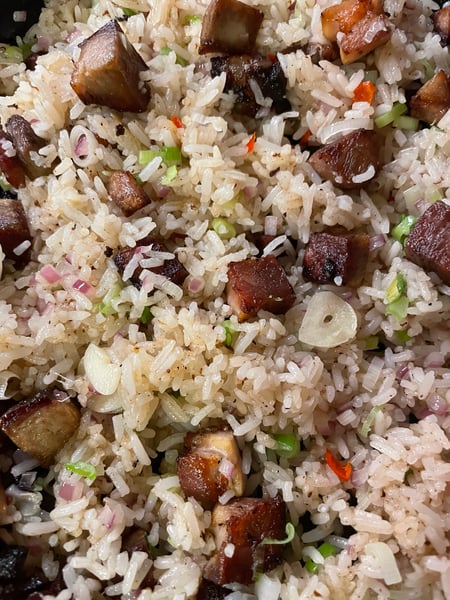 This is the point to add any other vegetable you might be using. You can either add them directly to the rice and stir them in to steam gently just like we did with the aromatics, or you can push the rice to one side of the pan and drop the veggies onto the exposed pan to cook them more directly.
This is the point to add any other vegetable you might be using. You can either add them directly to the rice and stir them in to steam gently just like we did with the aromatics, or you can push the rice to one side of the pan and drop the veggies onto the exposed pan to cook them more directly.
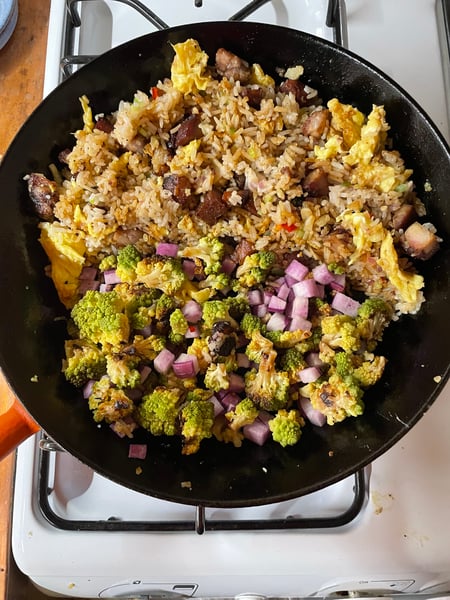 The keen eyed among you will notice there is already cooked egg in the fried rice in this shot. That's because I forgot to add the veggies in at the appropriate time, so I had to go back and cook them after. Its a pretty forgiving technique!
The keen eyed among you will notice there is already cooked egg in the fried rice in this shot. That's because I forgot to add the veggies in at the appropriate time, so I had to go back and cook them after. Its a pretty forgiving technique!
Once your veggies are just tender, push all the rice to one side of the pan exposing a half circle of bare pan. If you have enough oil in your pan that there is still ample lubrication you can go ahead and pour or crack in your eggs, otherwise add a bit more cooking fat before adding them. Once the eggs are in the pan turn off the burner. We will use the residual heat in the pan (which is why cast iron works best for this) to cook the eggs gently without turning them rubbery. Season the eggs lightly and cook to whatever degree you prefer before stirring them into the rest of the dish.
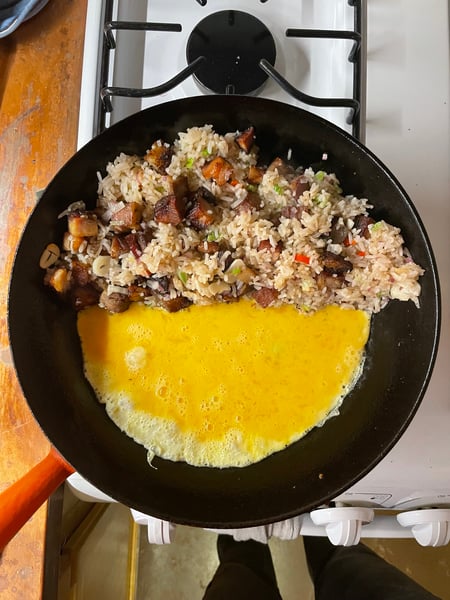
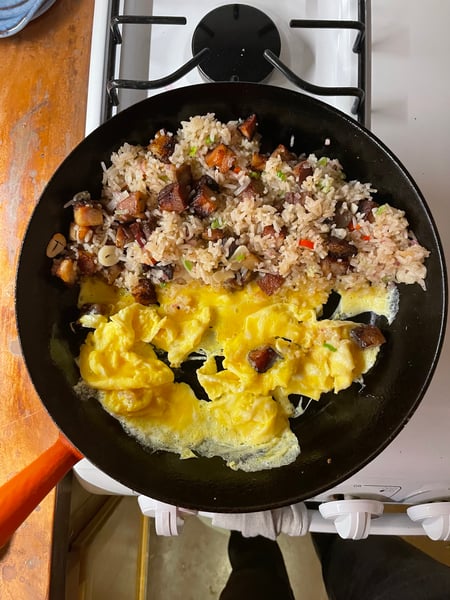 I like my eggs cooked about 75% of the way before stirring them into the rice, but you can cook them as much or as little as you like.
I like my eggs cooked about 75% of the way before stirring them into the rice, but you can cook them as much or as little as you like.
Once you’ve stirred in your eggs, all that's left to do is season. This is something done to taste, but I start with a sprinkle of light soy sauce (I recommend a light hand with the soy sauce for fried rice), a small pinch of MSG, and a few healthy grinds of black pepper.
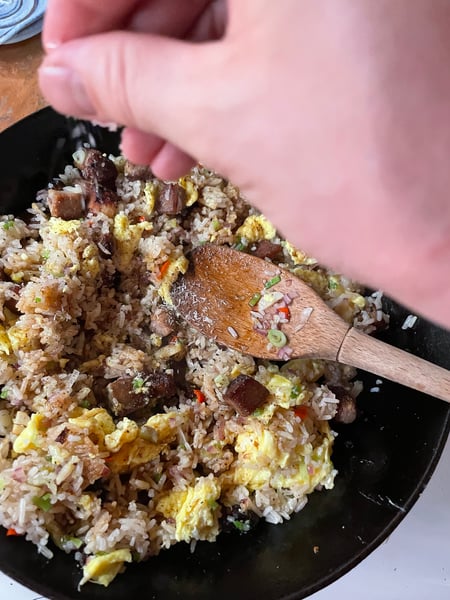
I find cooking over high heat the entire time and the cutting it for the egg cooking and seasoning portions gives just the right balance of small bits of crispy rice, with soft, fluffy eggs, and tender but not mushy veggies. At this point, our fried rice is finished so just plate up, and enjoy.
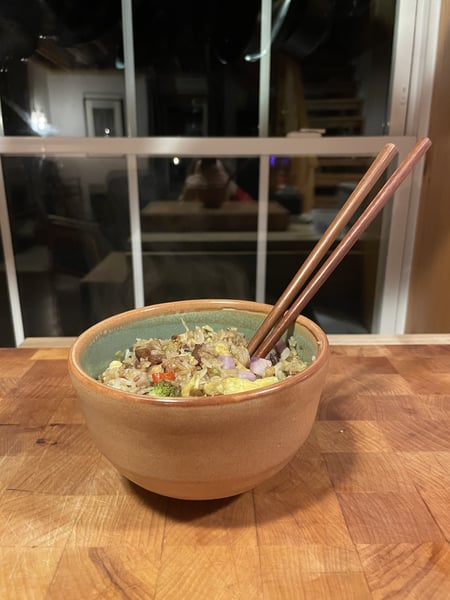 I hope this has helped you add a new versatile dish to your repertoire, and also a new outlet for anything languishing in your fridge that might otherwise meet a less glorious fate. If you’re interested in more method based (as opposed to recipe based) cooking tutorials, I recommend checking out our upcoming Virtual Pasta Shapes Workshop coming up this Sunday, November 6 at 11am CST. Hope to see you there!
I hope this has helped you add a new versatile dish to your repertoire, and also a new outlet for anything languishing in your fridge that might otherwise meet a less glorious fate. If you’re interested in more method based (as opposed to recipe based) cooking tutorials, I recommend checking out our upcoming Virtual Pasta Shapes Workshop coming up this Sunday, November 6 at 11am CST. Hope to see you there!

